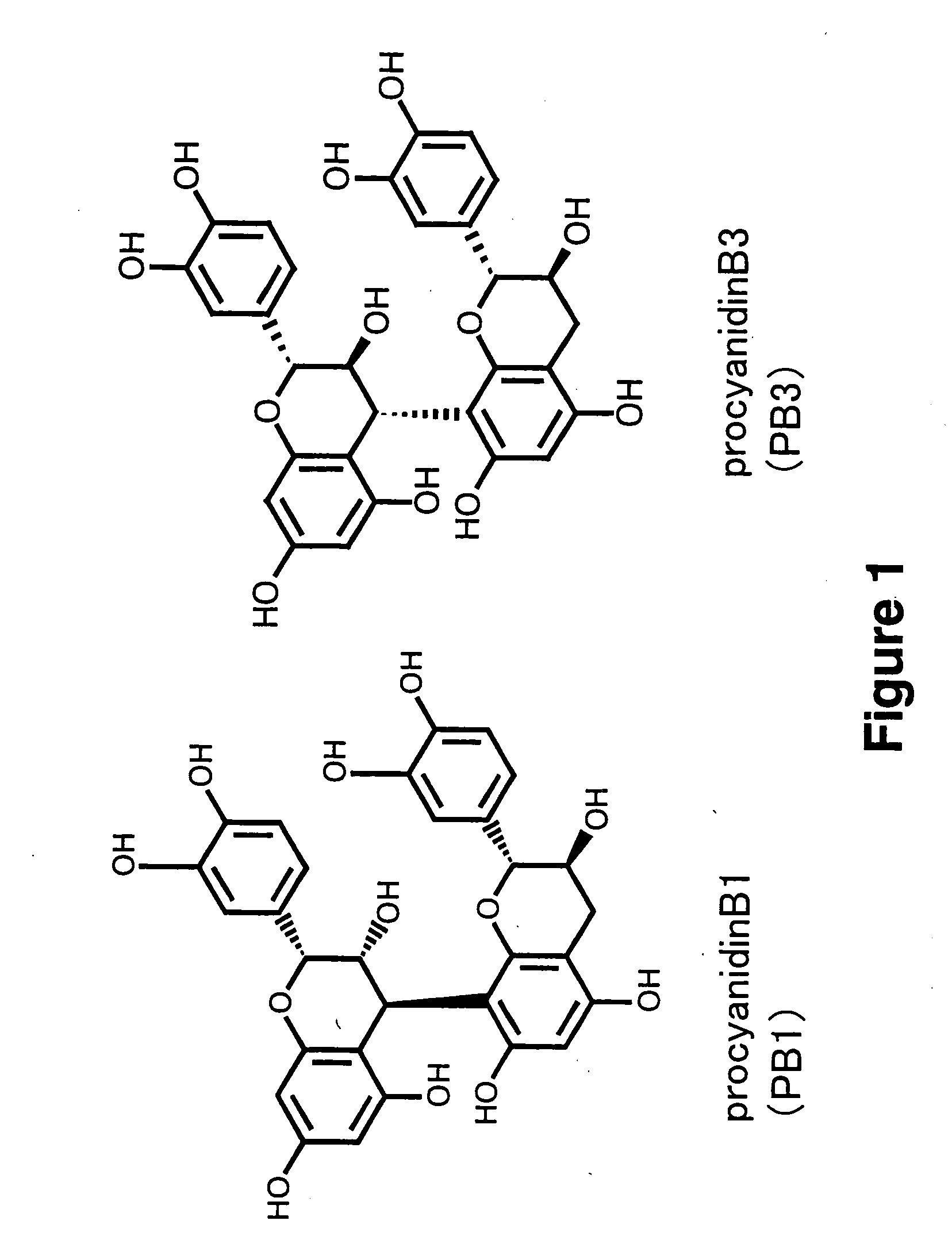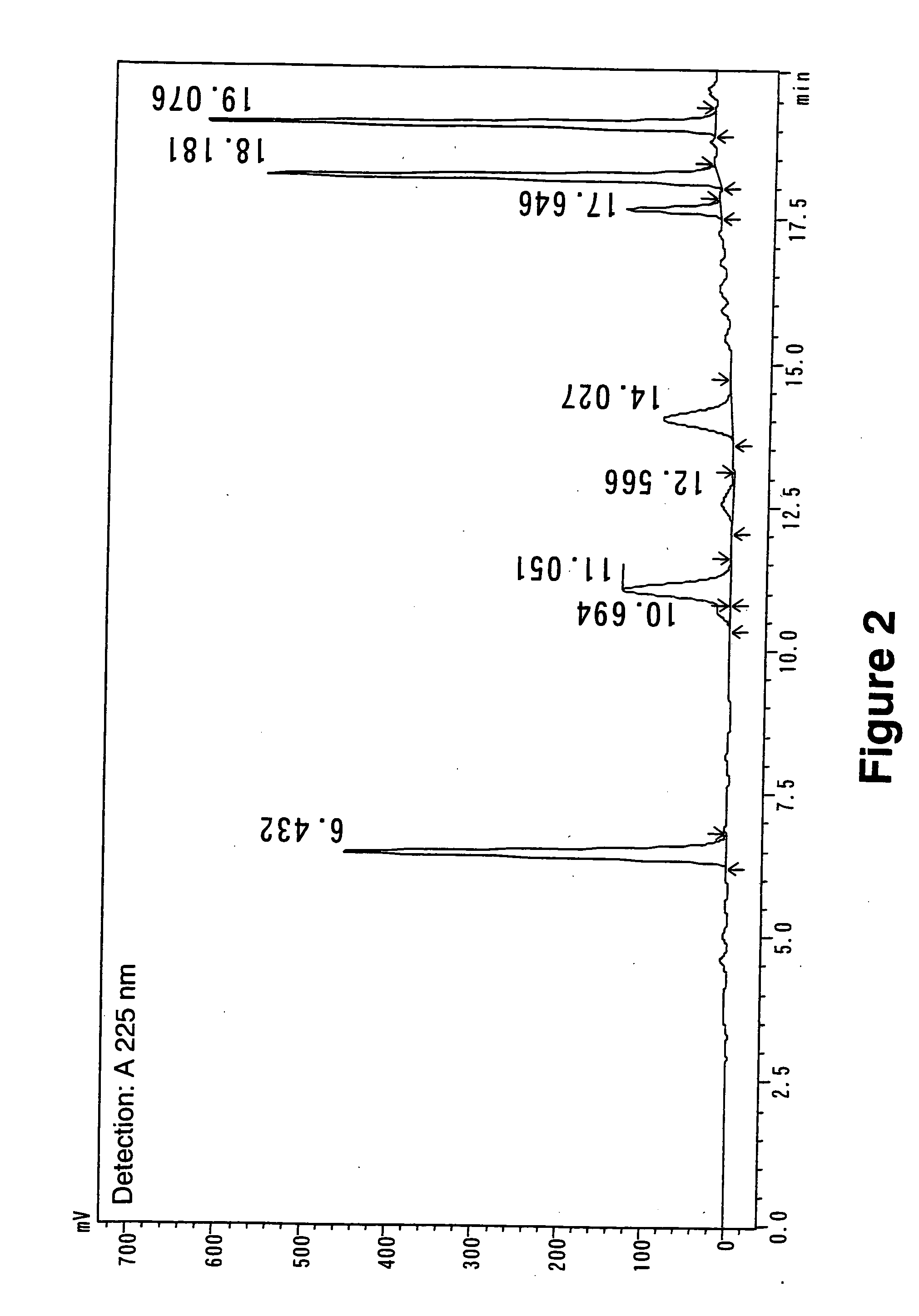Method for Procyanidin Analysis
a procyanidin and analysis method technology, applied in the field of procyanidin analysis, can solve the problems of inability to achieve accurate quantification and the limited amount of compounds available as standards,
- Summary
- Abstract
- Description
- Claims
- Application Information
AI Technical Summary
Benefits of technology
Problems solved by technology
Method used
Image
Examples
example 1
Study of Pretreatment Conditions
[0023]A column containing water-swollen Sephadex LH-20 (dry weight: 0.25 g; Amersham Biosciences) was loaded with 5 ml of an aqueous solution containing proanthocyanidin B1 (PB1) and caffeine (20 ppm each), washed with 2 ml water and then eluted sequentially with 20%, 40%, 60% and 80% EtOH (2 ml each). After concentration under reduced pressure, each eluted fraction was filled up in a 2 ml measuring flask and provided for HPLC (see Example 3 for analysis conditions) to quantify caffeine and PB1.
TABLE 1% Recovery of% Recovery ofEluentcaffeinePB1H2O (non-adsorbed)74% 0%H2O (washed)23% 0%20% EtOH2.5% 0%40% EtOH0%0%60% EtOH0%49% 80% EtOH0%27%
[0024]This result indicated that caffeine was substantially eluted with H2O, whereas PB1 was eluted with 60% or more EtOH. This means that caffeine and PB1 can be separated from each other.
example 2
Pretreatment of Tea Product on Sephadex LH-20
[0025]A column containing water-swollen Sephadex LH-20 (dry weight: 0.25 g; Amersham Biosciences) was loaded with 5 ml of a tea product containing flavangenol (pine bark-derived procyanidin), washed with 2 ml water and then eluted sequentially with 35% EtOH (2 ml) and 70% EtOH (4 ml). The fraction eluted with 70% EtOH was concentrated under reduced pressure and then filled up in a 2 ml measuring flask. Each eluted fraction was provided for HPLC (see Example 3 for analysis conditions) to quantify caffeine and PB1. The concentration was calculated on the basis of the initial volume (5 ml).
TABLE 2CaffeinePB1EluentconcentrationconcentrationH2O (non-adsorbed)100ppm0ppmH2O (washed)9ppm0ppm35% EtOH0.2ppm0.08ppm70% EtOH0ppm2.7ppm
[0026]Caffeine was almost completely eluted by washing with water. Subsequently, phenylpropanoids and flavonols were eluted with 35% EtOH, and the desired procyanidin and flavan-3-ol were eluted with 70% EtOH.
[0027]It sho...
example 3
HPLC Separation of Procyanidin and Flavan-3-ols
[0028]The fraction treated on Sephadex LH-20 and eluted with water, 35% EtOH or 70% EtOH, as well as the sample solution pretreated to remove contaminants such as caffeine were analyzed by HPLC under the following conditions.
[0029]Analysis conditions: Capcellpak C-18 AQ (6 mm×150 mm, Shiseido Co., Ltd., Japan) was used as a column, and gradient elution was performed using 0.05% TFA / water (Eluent A) and 0.05% TFA / 90% CH3CN / water (Eluent B) at a flow rate of 1.2 ml / minute with a gradient of 10% B→10% B (10 minutes) and then 10% B→35% B (10 minutes). The column temperature was set to 40° C., and detection and quantification were based on measurements of A225 nm and its peak area. The HPLC used was Shimadzu LC-2010HT (Shimadzu Corporation, Japan).
[0030]Under these conditions, procyanidin B1 was eluted at 10.7 minutes, procyanidin B3 at 12.6 minutes, catechin at 14.0 minutes, epicatechin at 17.6 minutes, gallocatechin at 6.4 minutes, epigall...
PUM
| Property | Measurement | Unit |
|---|---|---|
| temperature | aaaaa | aaaaa |
| volume | aaaaa | aaaaa |
| high performance liquid chromatography | aaaaa | aaaaa |
Abstract
Description
Claims
Application Information
 Login to View More
Login to View More - R&D
- Intellectual Property
- Life Sciences
- Materials
- Tech Scout
- Unparalleled Data Quality
- Higher Quality Content
- 60% Fewer Hallucinations
Browse by: Latest US Patents, China's latest patents, Technical Efficacy Thesaurus, Application Domain, Technology Topic, Popular Technical Reports.
© 2025 PatSnap. All rights reserved.Legal|Privacy policy|Modern Slavery Act Transparency Statement|Sitemap|About US| Contact US: help@patsnap.com


